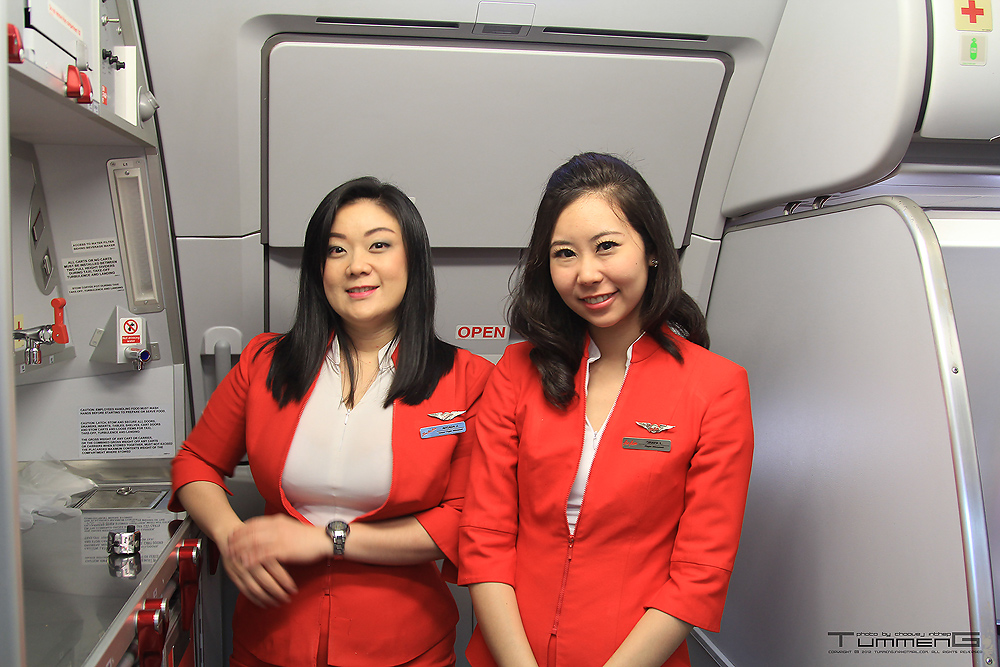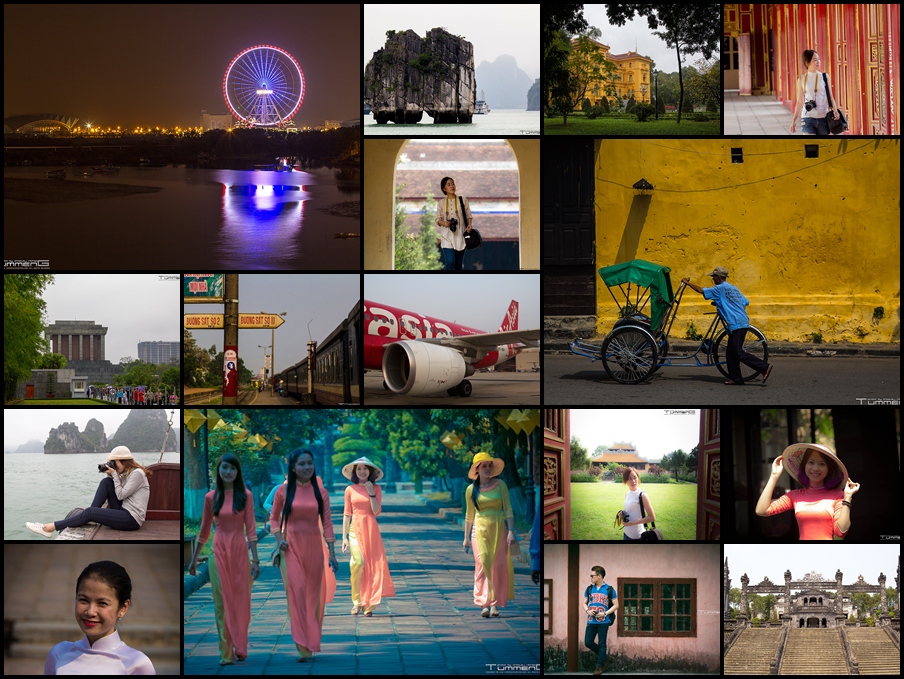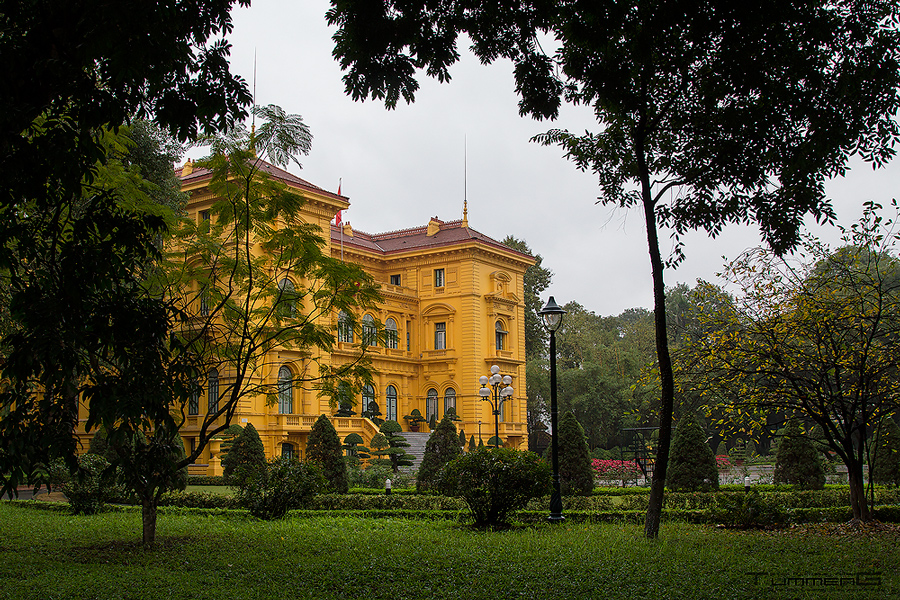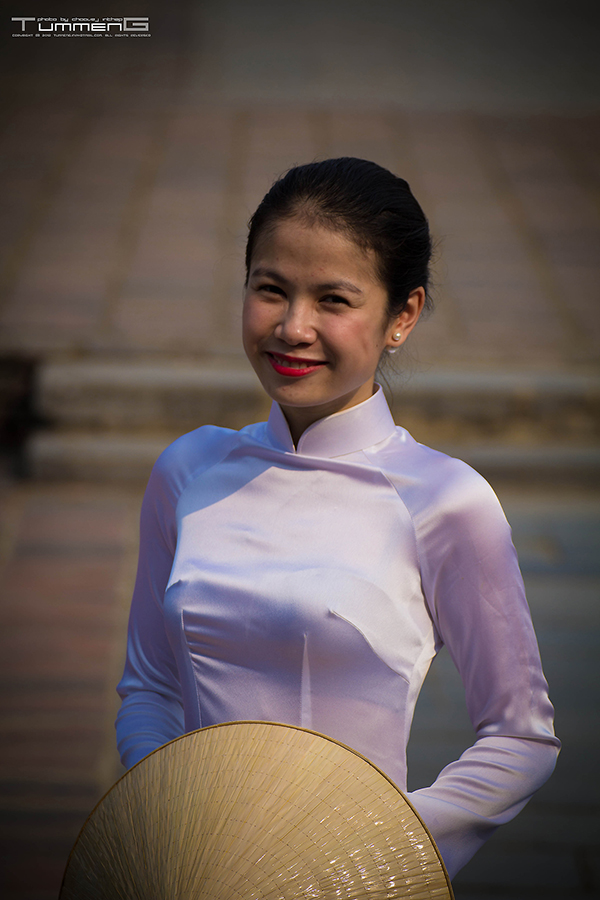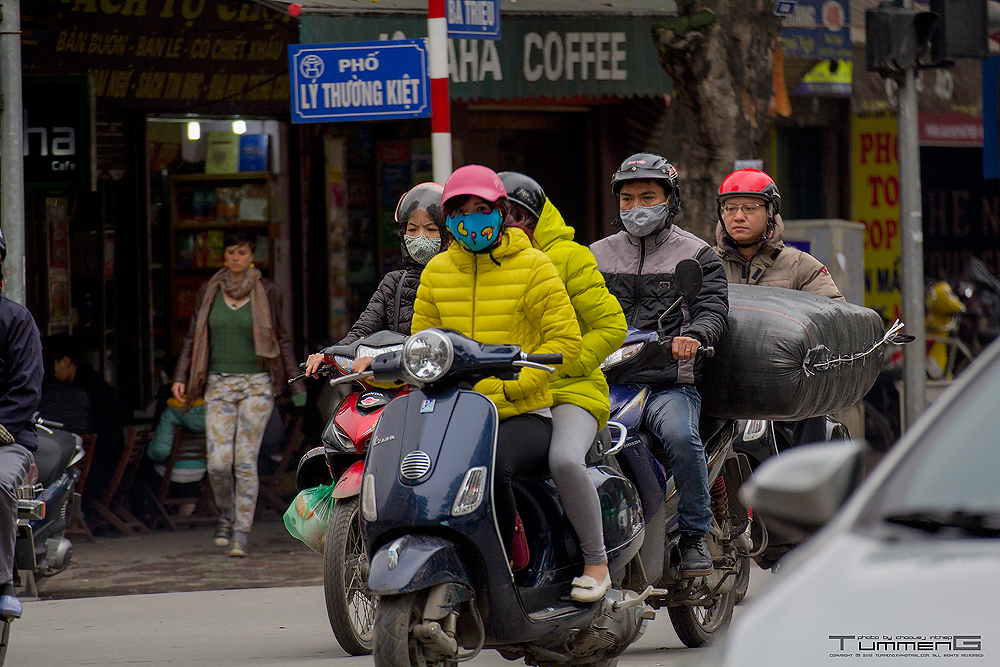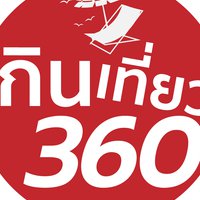Hello everyone, today Tummeng Travel has another great trip for you.
On this journey, I will take you all to experience the overnight sleeper train in Vietnam. It's a trip across Vietnam from north to south.
On this trip, I flew to Hanoi and then took a train to Hue and Da Nang. I then flew to Ho Chi Minh City and returned to Bangkok.
And on this trip, I traveled with many bloggers. Which made it a trip where I took a lot of fashion photos of people. Because as far as I went to Vietnam this time,
I think Vietnam is a country that is suitable for candid or street fashion photography.
This review will include photos of various tourist attractions along the route I took, interspersed with street fashion photos in my style.
I must say that I'm not good at taking pictures of people. This is probably one of the first posts with the most people in my review.
Feel free to check out my review of Vietnam in my own style.

########################################
SR = Airasiathailand sponsored this entire trip.
########################################
P.S. If this review is to the liking of many people, please leave a message to say hello so that I know that what I have done has pleased you.
If anyone wants to like or upvote, it's up to you.
Note: If you want to follow my travel journey or ask questions, for faster response, please visit
My fan page https://www.facebook.com/TummengMagazine

When I think of Vietnam, I think of the Ao Dai and the Non La. Vietnam was one of the first countries I had the opportunity to visit in the AEC. The last time I went was almost 10 years ago when I was working in Bangkok. At that time, I was working with the Department of Business Development, Ministry of Commerce. I didn't get to do much sightseeing. I went twice: once to Hanoi and once to Ho Chi Minh City.
This trip to Vietnam was an opportunity for me to see how much the country has changed in the past 10 years. I also got to visit Hue, Da Nang, and Hoi An, which have become popular tourist destinations in the last 5-6 years.
Let's go see it.


On this trip, I was invited by AirAsia Thailand to join a trip with 5 other bloggers to travel to Vietnam from north to south within 6 days and 5 nights. They also said that it was a private train trip. So I decided to join the trip this time.
AirAsia flies from Don Mueang to Hanoi every day, with one flight per day. It's the earliest flight in the morning, so I have to wake up at 4 am to compete for space with Chinese tour groups at the airport. 555

It took about 2 hours to fly to Noi Bai Airport in Hanoi. It's a relatively new airport, and it wasn't crowded either.

After waiting for our luggage for a while, it finally arrived. On this trip, our group also purchased travel insurance because Vietnam is known for lost belongings and food that may not be to everyone's taste.
Let's go when you're ready.
Here are the details of the tour, as listed below:
Day1 :: Bangkok > Hanoi > Ho Chi Minh Mausoleum > Temple of Literature > Ha Long Bay
Day2 :: Halong Bay Cruise > Thien Cung Cave > 36 Commercial Area > Ngoc Son Temple - Hoan Kiem Lake > Train station to Hue City
Day3 :: Hue City > Thien Mu Pagoda > Tomb of Khai Dinh Emperor > Dong Ba Market > Imperial Citadel > Seven-Storey Bridge
Day4 :: Hue Imperial Palace > Travel from Hue to Da Nang > My Khe Beach > Linh Ung Pagoda > Hoi An Evening Tour
Day 5: Hoi An Old Town > Late afternoon, return to Da Nang to catch a flight to Ho Chi Minh City.
Day6 :: Guji Tunnel > Ben Thanh Market > Notre Dame Cathedral > Post Office > Fly back to Thailand


After having lunch, we visited the Ho Chi Minh Mausoleum, which is located in Ba Dinh Square, which is a
A highly significant site for the Vietnamese people, as the body of Uncle Ho, or Ho Chi Minh, is preserved in a glass coffin. The body is remarkably well-preserved due to the temperature-controlled environment and the presence of numerous guards patrolling the area. Visitors must maintain silence, have their bags checked, and pass through a security scanner. Photography is strictly prohibited.
We then walked to see the Government House and the former residence of President Ho Chi Minh. The entrance fee is 25,000 VND, which is about 40 baht (600 VND = 1 baht). Vietnamese people can enter for free.


After leaving the first place, I went on to the next place.
This is "Wat Sao Deiao", where people are queuing up to pay their respects at the top. I'll pass, I don't like long queues, so I'll just take some pictures on the side of the road instead.


Oh, I forgot to introduce you. On this trip, we have a beautiful guide who will be with us throughout the trip.


After that, we continued our journey to the "Temple of Literature", which is called "Van mieu" in Vietnamese.
This literary temple was built to commemorate "Confucius" and it is also the first university in Vietnam.


After that, we took a van from Hanoi and drove all the way to Ha Long Bay. Along the way, I dozed off and woke up because I was tired from waking up early. I had the opportunity to take some pictures of the roadside. The atmosphere after leaving Hanoi was like a two-lane road in the countryside of our country. It was a small town alternating with rice fields.

It was already evening when we arrived in Ha Long Bay. We had dinner and then checked into our accommodation so that we could wake up early the next morning and head to the pier to take a boat trip to admire the famous Ha Long Bay, a UNESCO World Heritage Site in Vietnam.
We left the hotel early in the morning to catch the morning boat.

Upon arrival, there weren't many people around as it was still early, around 8 am. Many boats were waiting at the pier, and the sky was a bright white, as if it were about to rain. This trip made me think that instead of coming to Vietnam, I might end up in Argentina instead.

After boarding the boat, we set sail in the middle of Along Bay. It was completely different from what I had imagined. If it were a sunny day with clear skies, it would have been truly beautiful, as the rumors say. But what is this?

When the scenery wasn't pretty, I started taking pictures of my fellow travelers instead. 555





As we were happily taking photos, the boat took us to "Thien Cung Cave," also known as "Viman Sakawan Cave" in beautiful Thai. It is a large cave on an island in Ha Long Bay.
I must say that this is one of the destinations that every boat must stop by. Prague is very crowded.
Inside, there are stalactites and stalagmites, but they are decorated with colorful lights, which are quite beautiful.




Leaving Tian Kung, we set sail to explore the various islands before starting our return journey.
And start serving lunch on the boat. Sit and eat while enjoying the atmosphere. It's amazing.
And finally, the boat returned to the original pier.
The boat trip to Thien Cung Cave took about 4 hours, which only covered a part of Ha Long Bay. To see the whole bay, it might take days, and there are overnight tours available. That means taking a boat trip and staying overnight on the boat, leaving Ha Long and taking a bus back to Hanoi to catch a train to Hue.
This gives us time to visit another place, Hoan Kiem Lake, or Sword Lake.
Nestled on the serene waters of Hoan Kiem Lake, Ngoc Son Temple stands as a must-visit destination in Hanoi. Perched on a picturesque island, the temple is accessible via the iconic red bridge, known locally as The Huc Bridge. Visitors are welcomed with an entrance fee of 30,000 VND per person.
This temple is also a place where elderly people come to sit, chat, and play checkers, which is a common sight in the temple grounds.

Another iconic landmark here is the red bridge, which at first glance resembles a Japanese bridge.
When I saw the weather, I decided that this trip would focus on taking photos of people. So, the origin of this trip was to follow two alternative kids. 55




And on the opposite side of Hoan Kiem Lake, there is a 36-lane shopping district. This is a great shopping destination for tourists. The highlights are the cheap knock-off designer clothes and bags.



After finishing dinner, we went to the train station in Hanoi to travel to Hue. The journey takes 13 hours. This time, I had the opportunity to take a sleeper train in a foreign country again after my previous experience in India.

Vietnamese trains are almost always on time. We almost missed our train, so we didn't have much time to take photos at the station.


The sleeping compartments on Vietnamese trains are rectangular rooms with two double-decker beds on each side, offering a comfortable and spacious sleeping environment.

In the middle of the room is a place to put things with a power outlet. Each bed has one outlet, so it is recommended to bring a power strip.


If the room only has people from the same group, it would be comfortable. But if it's with people you don't know, it might be a bit awkward.
After a short nap, I woke up to find it was already morning. My friends in the group had already started taking pictures.

If you ask me how the Vietnamese train is, I would say it's much better than I expected, especially for someone who has experienced the Indian train. It's punctual, clean, and has food and drinks available. The carriages are not too old and not too crowded.
To truly experience the culture of a country, one must travel by train. This allows you to see how the locals live, eat, and travel.
Many times when I travel, I often try to blend in with the locals by taking the train.


After sitting for more than 10 hours, I felt stiff, so I got out to stretch my legs while the train was stopped at various stations.

Let's take some fashion photos in pajamas on the train. 555


After 13 hours, the train arrived at Hue Station, which was our destination for the third day of our trip to Vietnam.
They all got off the train and went to check in and shower at the hotel first, because there were no showers on the train.


For Hue city, let's start our trip here at Thien Mu Pagoda, a famous temple on the banks of the Perfume River. The highlight is the octagonal, seven-story pagoda that stands prominently in front of the temple.

Another important highlight of Thien Mu Pagoda is this blue car. Its significance lies in the year 1963 when the abbot drove this car to the heart of Saigon (now Ho Chi Minh City) and set himself on fire in protest against the government's forced conversion to Christianity and persecution of Buddhism. This temple is therefore of great importance to the people of Hue.
After being together for three days, the members started to get used to each other, so it was easy to persuade them to take photos together. This place has many beautiful corners to capture, so it was a great experience.


Walking and taking pictures, there was sunshine alternating with cloudy skies.




After looking around, I came out and waited in front of the temple for the van to pick me up. Because it's very difficult to park around here.



From Thien Mu Pagoda, we went to have lunch. After that, we continued our journey to another important historical site in Hue, the tomb of Emperor Khai Dinh. This tomb was designed by Emperor Khai Dinh himself. The exterior is magnificent with stucco, while the interior is beautifully decorated with paintings using colored tiles. This tomb is very beautiful.



As evening fell, we went to catch the sunset at the Imperial City of Hue, where according to the program, we will visit the inside again.

Before returning to our school, we stopped by to take pictures of the Seven-Colored Bridge of Hue City. Because this bridge lights up in seven colors at night for its nighttime beauty.


The next morning, we went to the palace of the city of Versailles again.
This palace is modeled after the Forbidden City in China. It is so vast that you could walk around for half a day and still not see everything.




The surrounding area is currently undergoing landscaping in several locations.
For those who cannot walk, there are horse-drawn carriages available to tour the palace.

As a teenager, I have to walk to make it easier to take pictures. 555

Whenever I find a beautiful angle with beautiful light, I stop to take a picture because I have plenty of time.



At the Royal Palace, you will see many Vietnamese girls wearing very revealing clothes. According to my inquiries, most of them are students on a field trip.


After leaving the Hue Imperial City, we had lunch and then took a van to cross the city again.
We will travel to Da Nang City, which takes about 3 hours.
Along the way, we will have to pass through a tunnel under the mountain called Hai Van, which is 7 kilometers long. Driving inside the tunnel, the speed must not be less than 40 km/h and not exceed 70 km/h. Do not drive fast to prevent accidents and do not drive slowly to prevent terrorism inside the tunnel. The Hai Van Tunnel was built to shorten the travel time between Hue City and Da Nang City. Instead of driving over the mountains, you can now go straight through the tunnel, saving a lot of time. Da Nang is a coastal city. In the past, it was a battlefield with the United States. After the war ended, the city was flattened. It was also hit by Typhoon Durian, which caused widespread damage. The land was abandoned and empty, with no buildings. Anyone who wanted to claim it could do so. It was an area that no one was interested in. But today, Da Nang is a city that has developed by leaps and bounds. The price of land now is almost impossible to afford. It is very expensive. The beautiful beachfront land has all become five-star hotels and resorts.


The beach you see is called Mi Khao Beach. The beach is very long, beautiful, clean and inviting for swimming. However, the beautiful parts were not captured in the photos. Instead, the photos capture the more interesting part, which is the left end of the beach.
Looking out, you'll see round things floating all over the sea. Coming down for a closer look, you'll find large bamboo baskets. These are the fishing boats of the local fishermen. They are bamboo woven boats called "Te Vien Tung" used for fishing near rocks where large boats cannot enter. They are only found in Vietnam. It's strange but cool. Seeing them makes me want to try sitting in one.


This beach must be a place where Vietnamese people of all ages come to relax in the evenings.


In the blink of an eye, our little sister went to the association with Vietnamese children.



Stop by to pay respects to the Goddess of Mercy at Lin Ying Temple in Laem Sen Ja to watch the sunset and capture the evening light here.

Da Nang is another city that is perfect for photography enthusiasts. This is because it has both beautiful bridges and stunning buildings.






For dinner tonight, we went for a walk to find some local food in Hoi An City, which is only 20 kilometers from Da Nang.

After dinner, we walked around the Hoi An night market, which is similar to a walking street in Thailand, but with more foreigners.
The next morning, I went out to capture the morning light at the beach.


Fishing boats will go out to sea to catch fish, bringing back squid, shrimp, and crab to sell to the merchants who are waiting to buy them at the beach.

The atmosphere is similar to a competition to process.

Some women wait for their husbands who went out to sea to return home.



In the late morning, we prepared to walk through the Old Town of Hoi An.

Take a walk around the city during the day. To enter the old town area, you must purchase an entrance ticket. The price is $10.

Our first stop is the Mae Tap Tim Shrine, where we can pay our respects and make offerings. If you're interested in making merit, you can participate in the "month-long incense" offering for 800 baht. Your name will be written on the incense stick, which will be lit and burn continuously for a month.





After that, we went shopping for brand-name copycats. We met up at the Japanese Bridge to gather together.
Hoi An was once a thriving port city of the Champa Kingdom. Many countries came to trade here. From this point, Hoi An has absorbed the arts and cultures of visitors, be it Chinese, Japanese, or other nations, and has blended them into a charming city.


And of course, it's another city with beautiful photo spots.
With its vibrant colors, the building is a beautiful example of ancient architecture.






Anyone who likes to take candid or street photos will probably love this city.

Leaving Hoi An, we headed straight to Da Nang airport to fly to Ho Chi Minh City. However, Vietnam Airlines made us miss the opportunity to walk around Saigon in the evening because the flight was delayed from 4 pm to 7 pm.

Upon arrival, Ojiment checked into their accommodation, had a meal, and then had to wake up early to brave the traffic jam to the Cu Chi Tunnels, another historical site in Vietnam.

This place is like an underground city. The ground has been excavated into various rooms that were used for fighting the Americans during the Vietnam War.




In the afternoon, we stopped by
The Ho Chi Minh City Central Post Office, with its striking yellow color, is a beautiful and eye-catching landmark. It remains fully operational to this day, offering postal services, selling commemorative stamps, and allowing tourists to admire its interior beauty.

And nearby, on the opposite side, is
This Notre Dame Cathedral, which adopts French architecture, is also one of the most beautiful churches in Vietnam and is also a popular venue for Christian wedding ceremonies for Vietnamese people.
And finally, we flew back from Ho Chi Minh City with Thai AirAsia on an evening flight because normally there are 3 flights a day from Don Mueang to Ho Chi Minh City, so you can choose a convenient time.

Summary of the trip to Vietnam from north to south
It was a fun and diverse trip, visiting various places in Vietnam.
Taking a train in Vietnam to travel North - Central - South is also convenient.
If you are planning to visit Vietnam, you can find more information from my trip.
Finally,
Thank you Thai AirAsia for inviting me to join this fun trip.
Thank you to all my fellow travelers.
And
Thank you everyone for visiting this review.
แบกเป้เท่ทั่วโลก
Friday, September 27, 2024 9:52 AM

![cover [Tummeng Travel] Taking a plane to ride a train in Vietnam, following the trend of taking pictures of children](https://asset.readme.me/files/48349/cover.jpg?v=9b2772b5)
![cover [Tummeng Travel] Taking a plane to ride a train in Vietnam, following the trend of taking pictures of children](https://asset.readme.me/files/48349/thumb.cover.jpg?v=9b2772b5)

